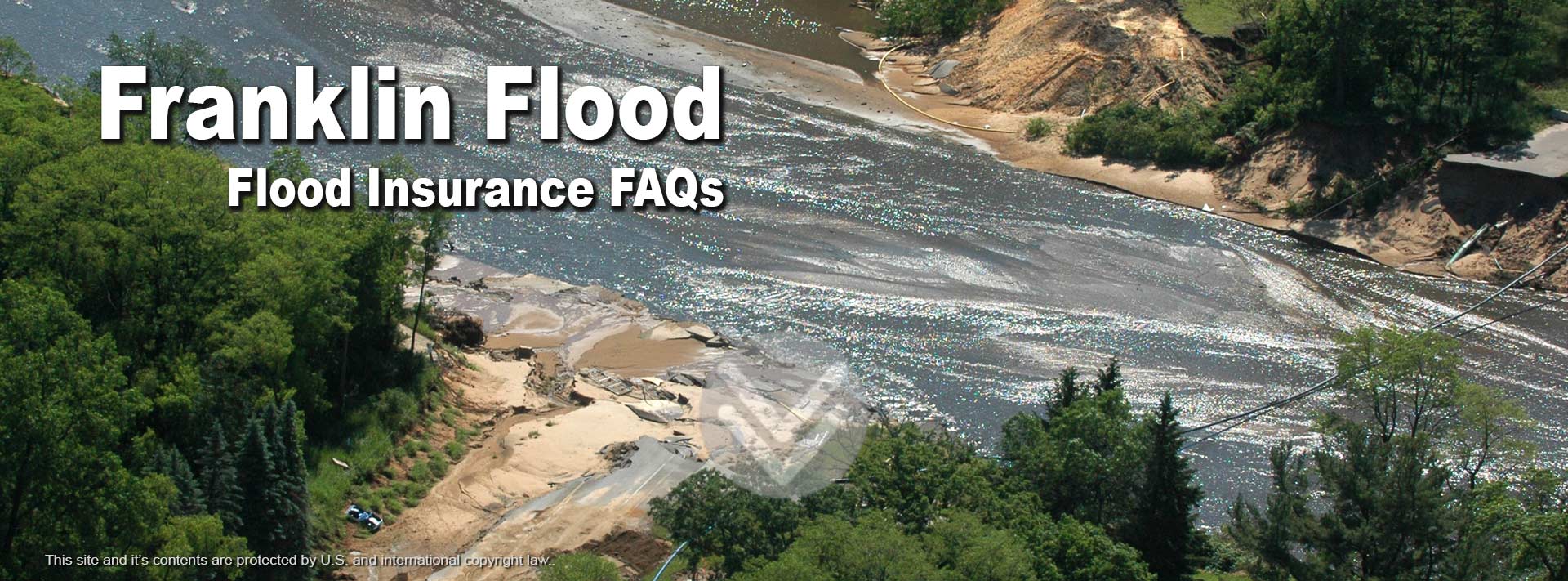Below is a compolation of frequently asked questions about floods, the National Flood Insurance Program and Flood Insurance Coverage. If you don't find the answers your looking for please contace a licensed Franklin flood insurance specialist for more information and answers to all your questions.
Q. Doesn't my homeowners insurance policy cover flooding? A. No, Flood damage is not covered by your homeowners insurance policy.
The Definition of a flood:
A general and temporary condition of partial or complete inundation of two or more acres of normally dry land area or of two or more properties (at least one of which is the policyholder's property) from any or all of the following:
Overflow of inland or tidal waters Unusual and rapid accumulation or runoff of surface waters from any source
Mudflow
Collapse or subsidence of land along the shore of a lake or similar body of water as a result of erosion or undermining caused by waves or currents of water exceeding anticipated cyclical levels that result in a flood as defined above.
Q. What does the "100-year flood" mean? A. The term "100-year flood" is misleading. It is not the flood that will occur once every 100 years. Rather, it is the flood elevation that has a 1- percent chance of being equaled or exceeded each year. Thus, the 100-year flood could occur more than once in a relatively short period of time. The 100-year flood, which is the standard used by most Federal and state agencies, is used by the National Flood Insurance Program (NFIP) as the standard for floodplain management and to determine the need for flood insurance. A structure located within a special flood hazard area shown on an NFIP map has a 26 percent chance of suffering flood damage during the term of a 30-year mortgage.
Q. What is a Base Flood Elevation (BFE)? A Base Flood Elevation (BFE) is the height of the base flood, usually in feet, in relation to the National Geodetic Vertical Datum of 1929, the North American Vertical Datum of 1988, or other datum referenced in the Flood Insurance Study report, or average depth of the base flood, usually in feet, above the ground surface.
Q. What is a Special Flood Hazard Area (SFHA)? A. In support of the National Flood Insurance Program (NFIP), FEMA has undertaken a massive effort of flood hazard identification and mapping to produce Flood Hazard Boundary Maps, Flood Insurance Rate Maps, and Flood Boundary and Floodway Maps. Several areas of flood hazards are commonly identified on these maps. One of these areas is the Special Flood Hazard Area (SFHA), which is defined as an area of land that would be inundated by a flood having a 1% chance of occurring in any given year (previously referred to as the base flood or 100-year flood). The 1% annual chance standard was chosen after considering various alternatives. The standard constitutes a reasonable compromise between the need for building restrictions to minimize potential loss of life and property and the economic benefits to be derived from floodplain development. Development may take place within the SFHA, provided that development complies with local floodplain management ordinances, which must meet the minimum Federal requirements. Flood insurance is required for insurable structures within the SFHA to protect federally funded or federally backed investments and assistance used for acquisition and/or construction purposes within communities participating in the NFIP.
Q. What is the policy period for a flood insurance policy? A. One year.
Q. If I don’t live in an area with a high flood risk, why do I need flood insurance? A. The National Flood Insurance Program states that between 20 to 25 percent of its claims are from outside high-risk flood areas.
Q. Can I buy flood insurance just before or during a flood? You can purchase flood insurance anytime. There is a 30-day waiting period after you’ve applied and paid the premium before your policy is effective.
Exceptions to this rule:
If you purchase flood insurance in connection with making, increasing, extending or renewing a loan, there is no waiting period.
Q. Who do I go to first for help with questions about my NFIP policy? A. You should call your insurance agent or insurance company first.
Q. Does my NFIP Policy cover all the buildings on my property? A. The Standard Flood Insurance Policy provides coverage for one building per policy. The only exception is 10% coverage for a detached garage. However, the total payment for flood damage to the detached garage and the house together cannot exceed the building policy limit. For coverage to apply, the garage can only be used for parking and storage. Any other use would void this coverage, i.e. if the garage has a workshop, the coverage would not apply. All other buildings on the premises need separate coverage. Policy limits for residential properties is $250,000 and $500,000 for commercial properties.
Q. Are the contents of my home covered under my NFIP Flood Insurance Policy? A. Contents are not automatically included. If contents coverage is desired a specific amount must be named and a separate premium charged, but it doesn’t need to be a separate policy. Contents coverage limits are $100,000 for residential policies and $500,000 for commercial policies.
Q. What is Actual Cash Value? Actual Cash Value (ACV) is the cost to repair or replace an insured item of property at the time of the loss, less physical depreciation. The value of physical depreciation is based on the age and condition of the item. Personal property, i.e. contents, is always paid at ACV.
Q. What is Replacement Cost Value? A. Replacement Cost Value (RCV) is the cost to repair or replace an insured item of property at the time of the loss without a deduction for physical depreciation. RCV is available when the insured property is the primary residence and the amount of coverage is equal to 80% or more of the replacement cost of the building. RCV is also available for residential condominium buildings. There is no required amount of coverage, but residential condominium buildings not insured to 80% of replacement cost will experience a reduction in their claims payments.
Q. Do I have to pay a deductible? A. Yes, all policies have deductibles for both building and contents coverage (if contents coverage has been purchased).
Q. I have a living area in my basement. Is that covered? Strict exclusions of coverage apply in any basement. A basement is defined as any area that is below grade on all four sides. In some cases, sunken living rooms can be defined as a basement. Building coverage in basements is limited to systems that service the building, such as electrical boxes, heat pumps and air conditioners. Contents in basements are not covered with a few exceptions such as a washer, dryer, freezer and the food in it. Similar exclusions of coverage also apply in any enclosure below an elevated structure if the structure is Post-FIRM.
Q. What does Post-FIRM mean? A. FIRM stands for Flood Insurance Rate Map. Post-FIRM means built after the effective date of the initial Flood Insurance Rate Map for the community or December 31, 1974, whichever is later.
Q. Does my NFIP Policy cover my additional living expenses when I cannot return home? A. No, there is no coverage for Additional Living Expenses or Loss of Use or Business Interruption.
Q. Does my NFIP Policy cover mold or mildew? A. Damage from mold and/or mildew resulting from the after-effects of a flood is covered but each case is evaluated on an individual basis. Mold and/or mildew conditions that existed prior to a flooding event are not covered. After a flooding event, the policyholder is responsible for taking reasonable and appropriate mitigation actions to reduce and/or eliminate mold and/or mildew. Reasonable actions taken to mitigate mold and/or mildew are covered (for example, the use of responsible drying-out techniques or application of mildicide at a reasonable cost).
Q. Does my NFIP Policy cover water backed up from the sewer? A. Back up of water from sewers and drains are excluded, except when caused by a flood.
Q. What is Increased Cost of Compliance, or ICC? A. This coverage provides up to $30,000 to comply with the community’s floodplain management regulations when a building has been substantially damaged by flood and is in a designated floodplain.
Q. Does my NFIP Policy cover landscaping or my deck? A. No, there is no coverage for landscaping, trees, decks or outdoor furniture. Other exclusions are found in the Standard Flood Insurance Policy.
Q. What is a Proof of Loss? A. A Proof of Loss is a legal document that is your statement of the amount you are claiming under the policy. Under the NFIP policy, your Adjustor may prepare a proof of loss as a courtesy. However, you, the insured, are responsible for submitting either the Proof of Loss prepared by your Adjustor or, you may prepare your own. Generally, you must submit it to your insurance company within 60 days of when the damage occurred.
Q. What do I do if I do not agree with my Adjustor? A. You should work with your Adjustor as long as possible. Ask your Adjustor to work with your contractor if your disagreement involves the building claim. If you cannot agree with your Adjustor, ask for assistance from his supervisor. If you still cannot resolve your differences, contact your insurance company.
Franklin for Agent Toolbox
What Agents are Saying about Franklin
" With a somewhat confusing product like flood insurance, it is especially nice to deal with an operation like Franklin Flood that explains and offers assistance to make our experience far less stressful." - The Shiner Insurance Agency - more...

Franklin Flood, LLC, 120 East Uwchlan Ave, Suite 101, Exton, PA 119341 Toll Free 888 567 9600 Fax 610 524 0900


This site and it's contents are protected by United States and International copyright law. Reproduction without permission is prohibited.




